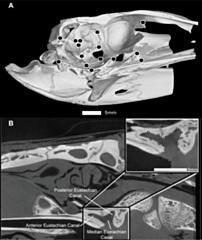Project 1154: M. E. Gold, A. Janke, C. A. Brochu, M. A. Norell. 2014. An Expanded Combined Evidence Approach to the Gavialis Problem Using Geometric Morphometric Data from Crocodylian Braincases and Eustachian Systems. PLOS ONE. 9 (9):e105793.
Abstract
he phylogenetic position of the Indian gharial (Gavialis gangeticus) is disputed - morphological characters place Gavialis as the sister to all other extant crocodylians, whereas molecular and combined analyses find Gavialis and the false gharial (Tomistoma schlegelii) to be sister taxa. Geometric morphometric techniques have only begun to be applied to this issue, but most of these studies have focused on the exterior of the skull. The braincase has provided useful phylogenetic information for basal crurotarsans, but has not been explored for the crown group. The Eustachian system is thought to vary phylogenetically in Crocodylia, but has not been analytically tested. To determine if gross morphology of the crocodylian braincase proves informative to the relationships of Gavialis and Tomistoma, we used two- and three-dimensional geometric morphometric approaches. Internal braincase images were obtained using high-resolution computerized tomography scans. A principal components analysis identified that the first component axis was primarily associated with size and did not show groupings that divide the specimens by phylogenetic affinity. Sliding semi-landmarks and a relative warp analysis indicate that a unique Eustachian morphology separates Gavialis from other extant members of Crocodylia. Ontogenetic expansion of the braincase results in a more dorsoventrally elongate median Eustachian canal. Changes in the shape of the Eustachian system do provide phylogenetic distinctions between major crocodylian clades. Each morphometric dataset, consisting of continuous morphological characters, was added independently to a combined cladistic analysis of discrete morphological and molecular characters. The braincase data alone produced a clade that included crocodylids and Gavialis, whereas the Eustachian data resulted in Gavialis being considered a basally divergent lineage. When each morphometric dataset was used in a combined analysis with discrete morphological and molecular characters, it generated a tree that matched the topology of the molecular phylogeny of Crocodylia.Read the article »
Article DOI: 10.1371/journal.pone.0105793
Project DOI: 10.7934/P1154, http://dx.doi.org/10.7934/P1154
| This project contains |
|---|
Download Project SDD File |
Currently Viewing:
MorphoBank Project 1154
MorphoBank Project 1154
- Creation Date:
11 March 2014 - Publication Date:
20 October 2016
Authors' Institutions ![]()
- University of Iowa
- American Museum of Natural History (AMNH)
Members
| member name | taxa |
specimens |
media |
| Eugenia Gold Project Administrator | 1 | 1 | 1 |
| Christopher Brochu Full membership | 0 | 0 | 0 |
Project has no matrices defined.
Project downloads 
| type | number of downloads | Individual items downloaded (where applicable) |
| Total downloads from project | 268 | |
| Project downloads | 258 | |
| Document downloads | 10 | Morphology and Molecules Only (8 downloads); 2D Procrustes Coordinates from braincase (2 downloads); |

